Lysosomes were organelles, first discovered by a scientist named Christian de Duve in the year 1955. Its structure was first studied by a scientist named Novikoff in the year 1956 by performing electron microscopy. The lysosomes function as “Digestive compartments” that helps in the degradation of complex molecules by the digestion enzymes.
A lysosome comprises about 40 kinds of digestion enzymes, which collectively refers as “Hydrolytic enzymes”. These are found abundantly in the cells or tissues that actively participate in the enzymatic digestion like liver, kidney, pancreas, macrophages etc. An animal cell contains many lysosomes, whereas a plant cell contains a single large lysosome or vacuole.
Content: Lysosomes
Definition of Lysosome
Lysosomes refer to the structures enclosed by a compartmental membrane and comprise several hydrolytic enzymes in its intercellular space. Generally, 40 types of hydrolytic enzymes are present in the lumen, such as proteases, nucleases, lipases, etc. All the lysosome enzymes belong to the “Acid hydrolases” class because they only function in the acidic environment.
The digestion enzymes of the lysosome create an acidic environment by using a hydrogen pump, where it uses cellular energy ATP to drive the transfer of H+ ions from the surrounding into the cell. Thus, the H+ ion maintains a pH level of 5.0 in the lumen of the lysosome.
Location of Lysosomes
Lysosomes are the membranous sacs or vesicles that carry a set of hydrolytic enzymes that cause the hydrolysis of large organic molecules into a simple form. These are present in almost all eukaryotes except:
Some fungi: Examples are Yeasts, Neurospora etc.
Protists: Euglena lacks a lysosome in its cell structure.
Plants: The meristematic cells of the plant is devoid of lysosomes.
Mammals: A mature mammalian RBCs do not contain lysosomes.
Types of Lysosomes
The matrix of the lysosome contains granular hydrolytic enzymes, which carry out the activity of digesting macromolecules into simpler forms. Lysosomes function in the digestion of biomolecules taken up by phagocytosis and sometimes function in the digestion of its cellular components by autophagy. Therefore, based on the nature of the matrix and the functions, lysosomes are of four types:
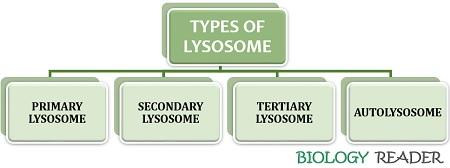
Primary lysosomes: These form after the processing of precursor molecules into the enzymes by the direction of the Golgi complex. It lacks the active particles or the hydrolytic enzymes for the process of digestion.
Secondary lysosomes: It also refers as “Heterophagosome”. Secondary lysosomes form after the fusion of primary lysosomes with cytoplasmic vesicles. It comprises active particles or hydrolytic enzymes for the digestion process. The cytoplasmic vacuole contains some extracellular particles, which goes into the cell via the endocytic process.
Tertiary lysosomes: These are the residual bodies, which only contains the undigested material. To expel the cellular debris into the environment, the residual bodies collide with the plasma membrane via exocytosis or ephagy. Lipofuschin pigment granule is an example of a residual body.
Autolysosomes: It also refers as “Autophagosome”. Autolysosomes originate from the fusion between the primary lysosome and the dead intracellular structures like mitochondria, Golgi body etc. Thus, it functions to eliminate the cell debris (contains injured, dead cells) out of the cell via “Apoptosis”.
Structure of Lysosome
The morphology of lysosome is quite simple, and it shares the following structural properties:
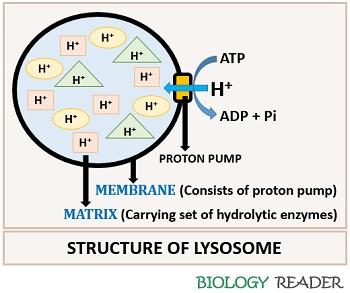
Size: The size of the lysosome ranges between 0-1-0.5 µm to 1.2 µm in length.
Shape: Its shape is invariably spherical.
Components: A lysosome typically contains an outer membrane and an inner matrix.
Outer membrane
A lysosome exists as a membrane-bound organelle and appears as a vesicle. Single membrane encloses a lysosome and functions as a protective layer that prevents the leakage of its own digestion particles or hydrolytic enzymes or separates the digestive protein from the other cells. A membrane comprises a proton pump that pumps in H+ ions from surrounding into the matrix to maintain the acidic environment for the functioning of hydrolytic enzymes.
Inner matrix
A lysosomal matrix contains a bundle of hydrolytic enzymes for the process of digestion and degradation. The hydrolytic enzymes cause hydrolysis of the large macromolecules by adding H2O to break the bond.
Example: Breaking of di-sulphide bonds between the protein molecules, breaking the glycosidic linkage between the carbohydrate molecules etc.
There are about 40 hydrolytic enzymes in the lysosomal matrix that can classify into the following groups:
Phosphatases: These are a group of enzymes that cause hydrolysis of phosphate linkages between macromolecules.
Example: Acid-phosphatase, Acid-phosphodiesterase etc.
Nucleases: These are the group of enzymes that cause hydrolysis of a phosphodiester bond between the nucleic acids (DNA and RNA) by converting it into sugar, phosphate and nitrogenous bases.
Example: Acid ribonuclease, Acid Deoxyribonuclease etc.
Polysaccharide or mucopolysaccharide enzymes: These includes the group of enzymes that cause hydrolysis of glycolysis bond.
Example: β-galactosidase, α-glucosidase, α-mannosidase etc.
Proteases: It includes a group of enzymes that cause hydrolysis of a peptide bond between the protein molecules and convert them into simple amino acids.
Example: Collagenase, Peptidase etc.
Lipases: These enzymes hydrolyze the ester bond between the lipid molecules and convert them into fatty acids and glycerol.
Example: Esterase, Phospholipase etc.
Formation of Lysosomes
A lysosome originates by the cooperation of cell organelles like the endoplasmic reticulum and Golgi apparatus. The precursors for the synthesis of the lysosome is provided by the rough endoplasmic reticulum (RER).
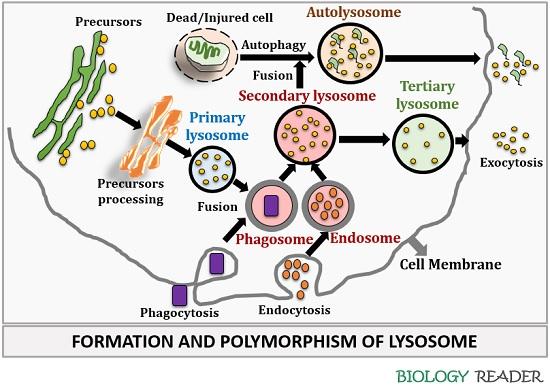
Then, the precursors are subjected to the Golgi body for processing via smooth endoplasmic reticulum or vesicles. A Golgi body performs a primary function in the processing of precursors into enzymes. A Golgi body pinches off these enzymes into a cytosol via budding in the form of small vesicles (forms primary lysosome). When these primary lysosomes fuse with the cytoplasmic vesicles, it gives rise to the formation of large secondary lysosomes as a result of fusion.
Functions of Lysosome
A lysosome is solely involved in the process of digestion and plays a significant role inside a cell by performing the following tasks:
Endocytosis
It is a kind of intracellular digestion, where a cell obtains its food from the surrounding via endocytosis, forming a cytoplasmic vesicle. A lysosome fuses with these food vesicles. It degrades the complex molecules by using hydrolytic enzymes and releases simpler food into the cytosol, which is further used by the cell for many purposes.
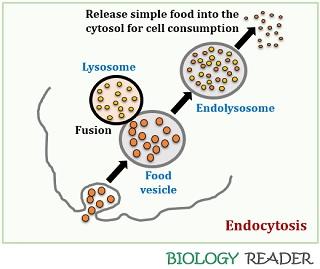
Exocytosis
It is a kind of Extracellular digestion, where a lysosome fuses with the cell membrane to release its contents like hydrolytic enzymes into the extracellular space for the ingestion of substances external to the cell surface.
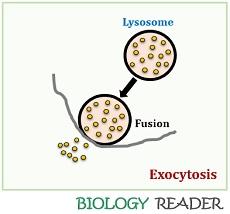
Phagocytosis
Sometimes microbes or some pathogenic substances attach to the cell membrane, after which a cell engulfs the whole particle by forming a phagocytic vesicle or phagosome. A lysosome fuses with the phagosome and helps in the digestion of such invaders by building a Phagolysosome.
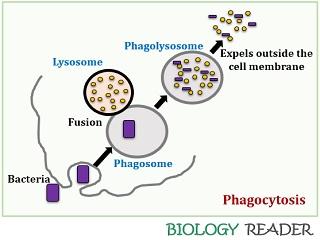
The digestion enzymes of the phagolysosome digest the microbial constituents into cell debris. A vesicle containing cell debris refers to residual bodies that further fuse with the cell membrane to throw unwanted particles into the surrounding.
Apoptosis
This process also refers as Self-eating or Autophagy, where the injured or dead cells are recognized by the isolation membrane, which firsts nucleate and elongate to form a vesicle around it, which refers to an autophagosome.
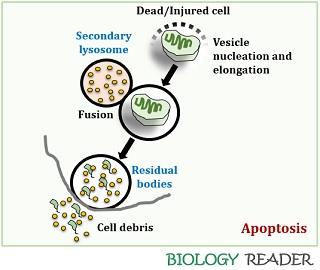
Then, a lysosome fuses with the autophagosome and helps in digesting its cellular components like mitochondria, ER etc., by forming an Autolysosome. The hydrolytic enzymes of autolysosome digest the cellular components into cell debris. A vesicle containing cellular debris fuses with the cell membrane to dispose it into the surrounding.